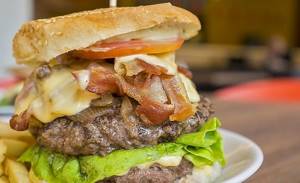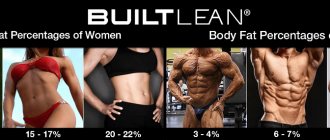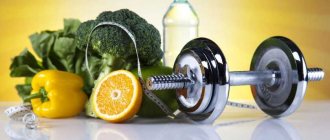What, how and in what quantity should you eat to grow muscles? How many calories and protein do you need? How different is eating to gain muscle from eating to lose weight?
The principles of proper nutrition are always the same and do not depend on the goal of losing weight or gaining muscle. Whole foods, protein, lots of vegetables, fruits, grains and healthy fats. In this sense, nutrition for muscle gain is no different from regular nutrition. There are no secret diet plans or growth-boosting supplements.
How many calories do you need to grow muscles?
Calories are just as important for muscle growth as they are for losing weight. Calories are energy. If to lose weight you need to create a calorie deficit, then to gain weight you need a surplus. From school physics we know that mass and energy cannot appear from nowhere and disappear anywhere. They can turn into each other.
But many still believe that they can build muscles out of thin air. And someone wants. As a result, a person simply marks time. He doesn't achieve results simply because he eats too little.
The main rule: for muscle growth you need a surplus of calories.
It should not be large - on average, it is 10% -20% above the maintenance norm. Those who are inclined to be overweight can follow the lower limit, and those who gain any weight with difficulty can follow the upper limit. If maintenance calories are 1800, then 180-360 calories are added above the norm. The final figure is 1980-2160 calories. You can start from the average figure - 39 calories per kilogram of weight, but for some it may be too much, and for others not enough. In any case, everyone will have to customize their diet to suit themselves.
The role of fats in the human body
Fat reserves in the body have completely natural and necessary functions: they are responsible for protecting internal organs and supporting the body if you have to starve. It helps to recover from illness and enables women to bear and feed a child.
However, if fat is allowed to exist uncontrollably, in quantities that exceed the norm, it will begin to influence a number of processes occurring in the body. Abdominal fat affects and disrupts hormonal levels. With a high fat content, internal organs work hard. The body requires more and more calories, accordingly, the person overeats and gains even more weight. Excess weight puts stress on joints, blood vessels, limbs, and increases the risk of a huge list of diseases.
Therefore, it is important to keep your fat level normal and get rid of excess deposits. At the same time, it is important to know not only how many calories are in one kilogram of human fat, but also how to burn it correctly, since with a sharp and incorrect weight loss, it is not fat that will be lost first, but fluid and muscle mass, and the consequences can be very dangerous.
If you lose weight very quickly, you will lose more muscle mass than fat . As a result, muscle tissue that is capable of burning fat will disappear, and metabolic processes will slow down. Fats do not consume as many calories as muscles, which are destroyed under the influence of rapid weight loss. At the same time, the overall appearance of the body deteriorates, as the skin sags. When the diet comes to an end, the body first of all restores lost fat reserves, and only then begins to restore muscles, but still not to the same extent as before. As a result, weight becomes less, but not due to fats - there are more of them in the body, even if the weight is the same.
To maintain your weight at the same level, you need to consume significantly fewer calories, since fat uses nine times less energy than muscle mass. That is, you will have to go on an even stricter diet. And these are new negative consequences. The body will not cope with the restrictions, and will try to do everything to ensure that the fat in the body remains and increases, because it is a reserve in case of just such emergency situations. Metabolism will slow down significantly and, thus, you will only worsen both your figure and your health, although you want completely opposite results.
How much protein do you need for muscle growth?
Everyone knows about the importance of protein for muscle growth, because muscles are made of protein, right? Not really. Muscles are composed mainly of water. There are about 250 grams of pure protein per kilogram of muscle. Although protein is still the building material of muscles and should be in food. In general, you can aim for a range of 1.7 to 3.3 grams of protein per kilogram of body weight.
There are those who grow well at the lower end, and there are those who grow well at the upper end. This may depend on your body and how protein interacts with the rest of your diet. Today it is impossible to say exactly in advance. .
Do you need to drink protein powder for muscle growth?
Protein powders are just another source of protein. If you get enough protein from regular food, there is no need for sports nutrition.
Protein supplements have their obvious advantages: a lot of protein per serving, good amino acid composition, no fat and carbohydrates, and few calories. As well as rapid absorption, which under some conditions is important in nutrition around a workout.
There are also disadvantages. If we do not take into account the issue of quality and fakes, then one of the main ones is poor saturation. Protein shakes do not satisfy the feeling of hunger well.
Why are protein standards so high?
But the sports nutrition industry is financially interested in selling more. And magazines are promoting this idea due to collaboration with sports nutrition manufacturers.
Secondly, bodybuilding is a sport that is no stranger to anabolic steroids. People who use go beyond the limits of physiology. They really need more protein as a building material.
In ordinary people, without enough protein, muscles do not grow, but after a certain threshold, more does too. More protein in your food does not mean more muscle. The process of synthesis of new muscle protein proceeds at its own specific speed.
A good example. Your muscles are your home. Protein amino acids from regular food or sports nutrition are the building blocks for its construction. The workers who will build are different hormones: testosterone, insulin, IGF-1, etc. Their salary is calories. There may be further options:
- If you send bricks from time to time, irregularly, construction will take a long time or stop.
- If you send more bricks than the workers are physically capable of laying in a day, the excess will remain unused (deposited as grease or burned). You can call in an additional team of workers (steroids), but it’s not worth it.
- If you don't pay wages (there are enough calories), the workers will not be motivated and construction will stop. But if you shower them with money, they still physically won’t be able to work faster after a certain limit. Thus, the excess goes into storage, into fat.
How to lose weight correctly?
To get rid of a kilogram of fat under the skin and around organs without losing muscle mass, you need to consider the consequences of the actions you perform. After all, physical activity and diet not only allow you to get rid of fat deposits, but can also act as a reason for the loss of necessary muscle mass.
To do this, you need to follow a number of recommendations:
- Having decided how many calories are in 1 kg of fat, you also need to calculate the amount of protein in the diet. The productivity of weight loss largely depends on it. According to general rules, this value varies from 10% to 35%. With large amounts of protein, the risk of losing muscle mass decreases and the likelihood of gaining it through physical activity increases. Therefore, during the diet you need to add protein foods to the menu.
- maintaining a sleep schedule. It is important for both a healthy person and an overweight body. It is important to sleep at least 8 hours, and it is better to go to sleep before midnight. Chronic lack of sleep can cause bad mood, overeating, laziness, and slower hormone production;
- physical activity. There is no need to spend hours of free time working out in the gym. It is enough to approach the formation of exercises correctly, which will allow you to avoid unnecessary time expenditure and achieve the desired effect. Special attention should be paid to cardio training, adding strength training to your usual physical activity. If you are unable to perform such exercises, you can use yoga or Pilates - with their help you can also engage and develop the necessary muscle groups;
- ensure compliance with nutritionist requirements. For several days after the transition to the process of losing weight, the human body strives to adapt to a smaller mass, so metabolic processes slow down, which reduces the effectiveness of the actions performed. In this regard, you need to change the exercise plan every two weeks.
Knowing how many calories are in a kilogram of human fat will not allow you to lose excess weight. In addition, a person needs to study the recommendations of doctors and ensure compliance with them.
What workouts might be suitable?
When burning calories through physical activity, you need to take into account a number of factors that influence the effectiveness of your actions:
- age;
- current height and weight;
- presence or absence of health problems;
- habitual physical activity;
- diet
Exercises and their duration must be selected taking into account the above positions. As for activities that allow you to get rid of excess weight, you can highlight:
- jogging in the mornings or evenings – at least 20 minutes;
- jumping rope – from 10 minutes;
- swimming - from 15 minutes crawl;
- fitness – 30-40 minutes of moderate intensity exercise.
You need to try to make more movements at home. If you cannot move at the prescribed pace throughout the day, you should spend more time walking in the fresh air.
Any activity is useful for people who have learned how many calories are in 1 gram of fat and want to achieve standard values for this indicator.
How to stick to a diet correctly?
In the future, after becoming familiar with how many calories are in one kilogram of fat and how to lose excess weight, you will need to clarify the specifics of losing weight with food. Without changing the menu, you will not be able to achieve the result. The construction of the diet should be carried out in accordance with the recommendations of nutritionists:
- It is necessary to eat food without haste, because it also takes a lot of energy to digest the incoming food by the stomach. It is important to chew each piece thoroughly without rushing. It is better not to be distracted by various irritants such as a smartphone, laptop or television;
- compliance with the drinking regime. This especially applies to summer time. You need to take chilled liquid more often. Depending on the specific diet rules, frozen juice or frozen berry sorbet may be consumed;
- When creating a breakfast, you need to take into account that the morning meal should consist of complex carbohydrates and fiber. To digest dishes with such content, the body needs more time, which will have to burn more calories;
- there is no need for a critical reduction in diet. Yes, this way you can lose weight in a short time, but this approach will not provide long-term results. At the same time, there is a high risk of negative consequences for the human body. Therefore, you need to give preference to small adjustments to your menu and habits - both at home and at work.
Metabolic speed and daily routine are individual for each person, so nutritionists recommend first reducing your daily diet by 300 kilocalories. You should also, before initiating the weight loss process, consult a doctor who will help explain how many kcal are in 1 kg of human fat and what rules must be followed to achieve the desired result.

IMPORTANT! Informational article! Before use, you should consult a specialist.
source
How many carbohydrates do you need for muscle growth?
General recommendations are 4.4-6.6 grams of carbohydrates per kilogram of body weight. Here again, there are those who achieve better results on high carbohydrates, and there are those who do not tolerate large amounts of carbohydrates well.
There are two variables that influence carbohydrate intake here: training volume and insulin sensitivity.
Training Volume
Volume is the total number of approaches per workout. For example, each exercise consists of three approaches. If you have eight exercises in the program, your training volume is 24 sets.
It is very roughly calculated that for every 2 approaches the body spends 5 grams of carbohydrates. If your workout has a total of 24 sets of all exercises, the body spends 60 grams of carbohydrates on them, which must be replenished with food (24 sets * 5 g/2 sets). This figure is not a strict guide to action, but it shows that a huge amount of carbohydrates is not required to gain muscle unless a person does several dozen sets per workout.
Insulin sensitivity
Insulin sensitivity measures how well muscle cells respond to insulin and take glucose from the blood. Genetic sensitivity to insulin can vary up to 10-fold from person to person. When we talk about good genetics for bodybuilding, this is also what is meant.
So people with good insulin sensitivity can afford more carbohydrates in their diet and can more effectively store carbohydrate calories into muscle rather than fat. People with poor sensitivity should eat fewer carbohydrates. This way, they not only feel better, but also grow better, without adding a lot of fat in the process of gaining muscle.
How do you know how sensitive you are to insulin?
You can try an experiment or remember:
1. What did you notice after eating a high carbohydrate meal? It is important to choose foods without fat: muffins and sweets are not suitable. Pasta, rice, potatoes, bananas, bread are fine.
- a) muscle fullness and better relief. This may indicate good carbohydrate tolerance.
- b) heaviness, fullness and swelling. This is not good carbohydrate tolerance.
2. After eating a lot of carbohydrates, you feel:
- a) vigor, energy, burst of strength. This means you have normal levels of insulin secretion.
- b) loss of strength, drowsiness and rapid hunger after an hour. Perhaps insulin secretion is increased. This causes your blood glucose to drop sharply, making you sleepy and hungry.
Strength training increases muscle sensitivity to insulin. This is the most powerful tool we can use. But for people with poor sensitivity, carbohydrates should still be kept in moderation even during the muscle growth phase. In this case, 150 grams of carbohydrates per day may be sufficient (this is not the weight of cereals, but the weight of carbohydrates). The remaining calories come from protein and fat to normal levels.
How are fat cells broken down?
Regardless of how many kilocalories there are in 1 kg of human fat, you need to take into account the features of fat breakdown. The procedure is implemented in the following order:
- To initiate the process, it is initially necessary to reduce the level of fatty acids in the blood through diet, supplemented by sports exercises to increase the concentration of breakdown products. The latter are responsible for energy volumes and require fatty acids to replenish them.
- After entering the blood, fatty acids mix with proteins and albumins. The volume of these components determines blood viscosity and albumin values. This is another indicator that is important to track when losing weight quickly.
- Acids are used to replenish energy resources that are spent through active physical exercise, which helps reduce the amount of fat in the body.
Important: if weight loss is carried out too quickly, the resulting activity can cause severe wear and tear on the cardiovascular system and kidneys. Therefore, it is important to lose weight gradually.
It is also necessary to take into account that getting rid of extra pounds only through diet, without exercise, can cause complications. Thus, in the absence of active exercise, weight loss can lead to an increase in the volume of fatty acids in the body, which contributes to the formation of cholesterol in the blood vessels. If muscle tissue does not burn fat, it can also affect the liver, overloading it. This can lead to cirrhosis.
Therefore, understanding how many calories are in a gram of fat is not enough to get a complete answer to questions related to effective weight loss.
Putting it all together
There are many variables that determine what works and what doesn't for a particular person. Training program, training effort, genetics and other factors all play a role. But the general picture of nutrition for muscle gain looks like this:
- Calories: +10-20% to weight maintenance norm
- Proteins: 1.76-3.3 g/kg
- Carbohydrates: 2.2-6.6 g/kg
- Fats: 1-2.2 g/kg
If you are wondering about calories for muscle growth, then most likely you are already at least superficially familiar with the topic of this issue.
It’s no secret now that to gain weight per day you need to consume 2-3 grams of protein and 7-8 grams of carbohydrates per kilogram of body weight, but the problem is that it doesn’t always work.
This problem is purely individual in nature and depends on the metabolic rate in your body. Thus, with a high metabolism, if you consume 3-4 grams of protein and 8-10 grams of carbohydrates per kg. Based on your weight, it is not a fact that in a month you will gain even 2-3 kilograms, because this amount of nutritional value does not cover the energy consumption of your body. That is why, all those who cannot gain weight are advised to ask the question: “How many calories do you need to consume per day in order to start growing?”
Properties of human fat
There is an opinion that the number of fat cells in the body is determined by a hereditary factor, such as eye or hair color. However, there is other information that refutes this opinion, and it lies in the fact that the number of fat cells in a child is determined by how the mother ate. It also became known that in obesity, fat cells can divide on their own, and then only surgical intervention can help overcome them.
Fat in the body is divided into several types: brown, subcutaneous and internal . The brown type of fat is needed so that the body can maintain the correct temperature. There is enough such fat in the body of infants - it protects them from hypothermia. Subcutaneous fat, as its name implies, is located directly under the skin and is the familiar cellulite. This is exactly the type of fat that we constantly struggle with. As for internal or visceral fat, it is deposited on the surface of human organs and inside them. Fat can grow into muscle tissue and even penetrate into the heart.
Together with the blood, excess fat circulates through the vessels, clogs them, and is deposited on the wall. It becomes difficult for blood to penetrate the body's cells, blood pressure rises, and possible malaise. Cholesterol plaques cause stroke and heart attack. Therefore, it is important to get rid of not only the fat that is visible to the naked eye, but also to free the internal organs from it. Despite the fact that the effects of different types of fat are different, their calorie content remains the same.











